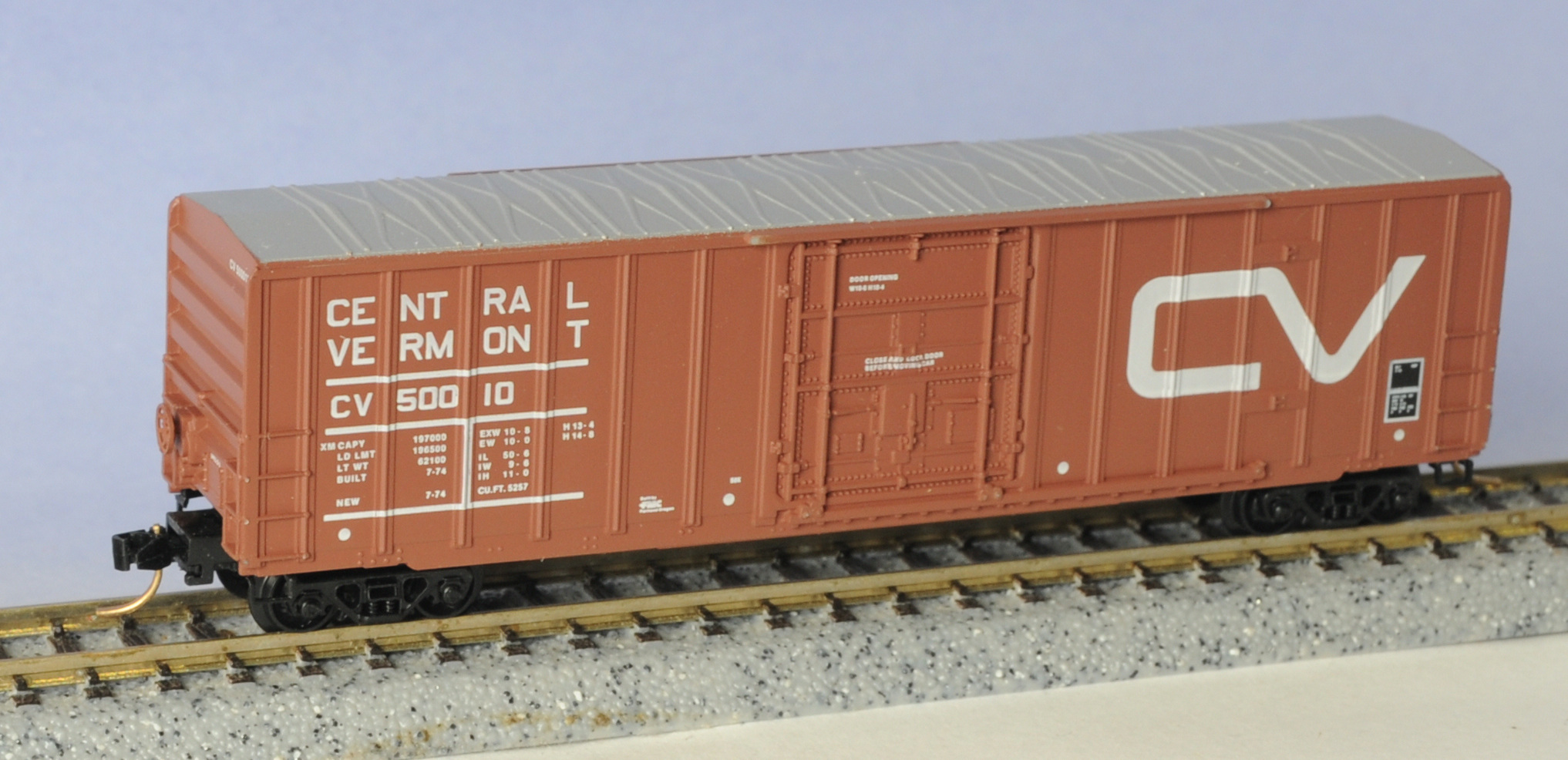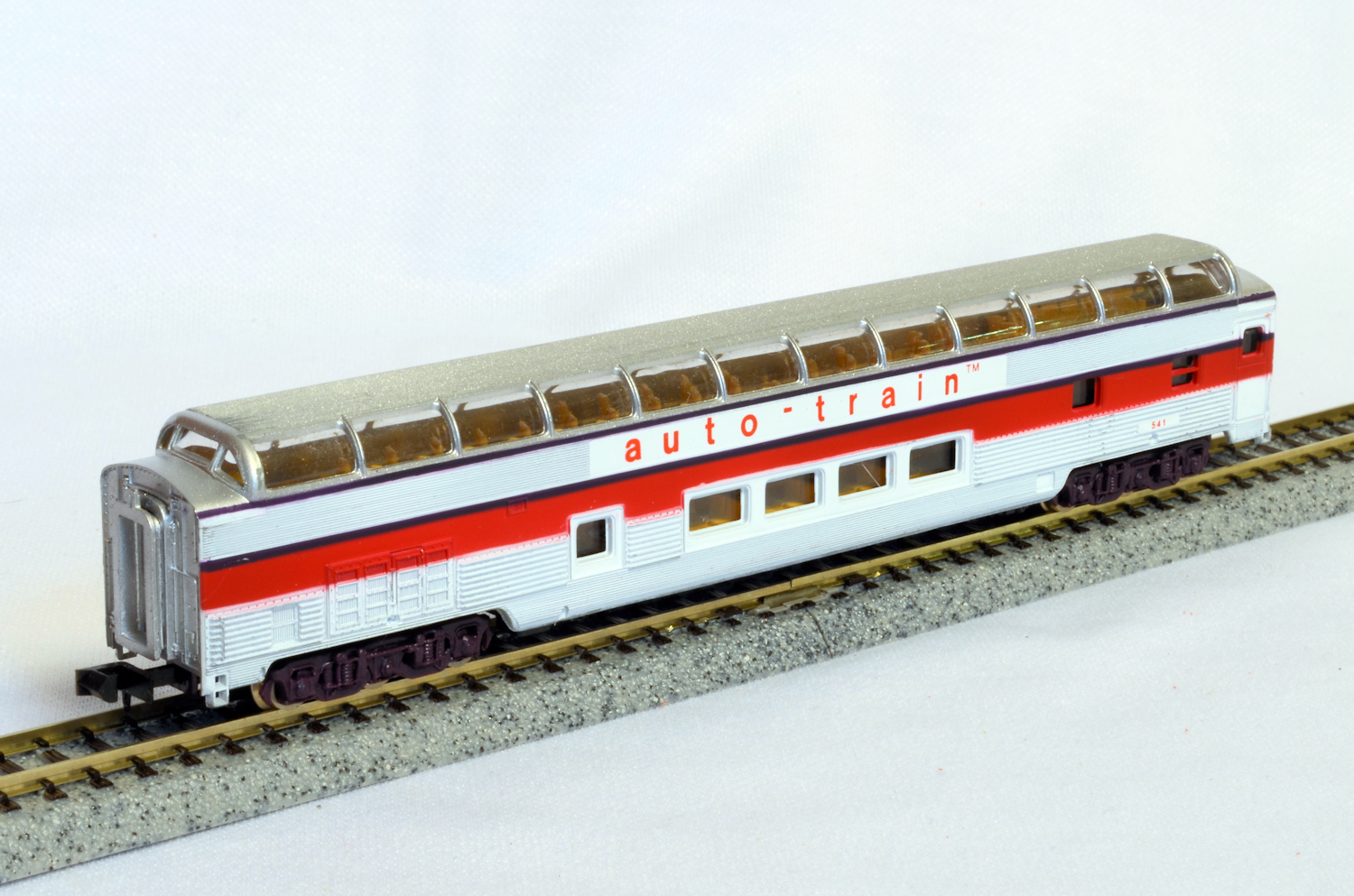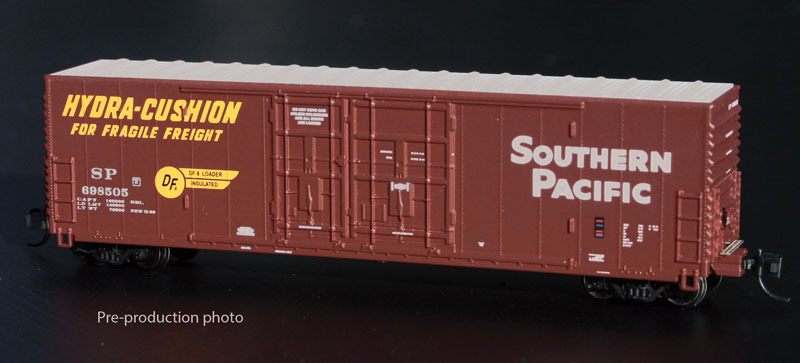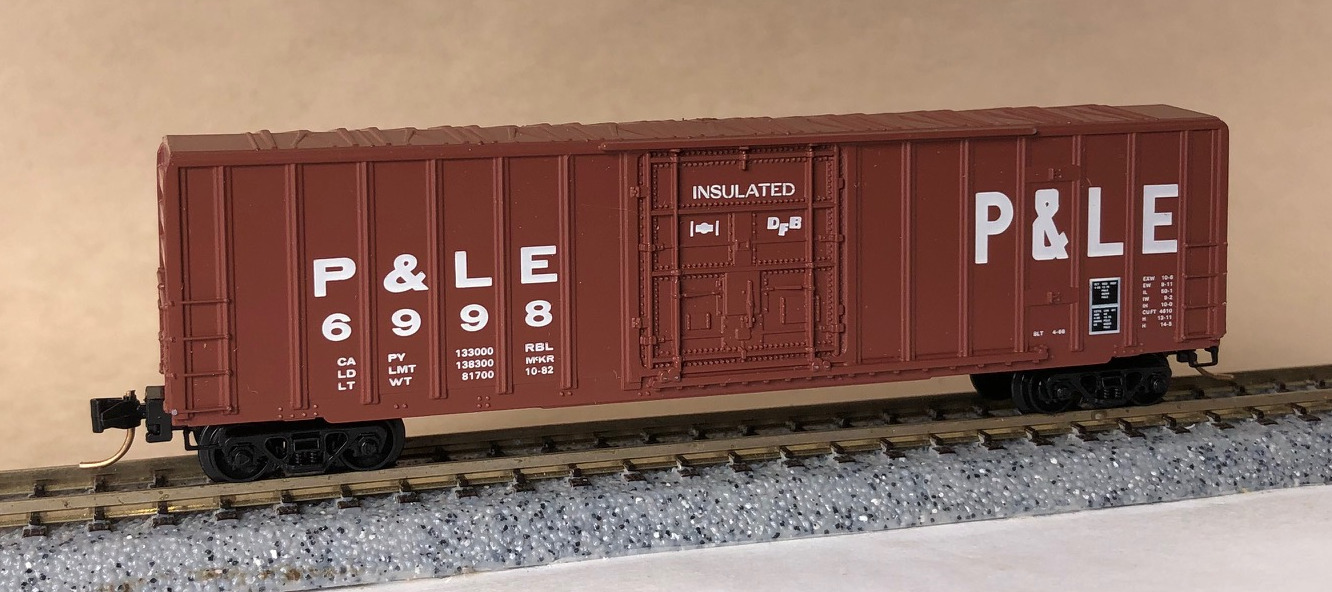Model Information: Introduced in September of 1983 with ATSF 151900 and 151951, Micro-Trains has produced 83 different versions of this car (as of March, 2016). Body style 027 represents a 50 foot prototype "Plug" single-door Box Car. Unlike the "Sliding" door, the plug door system closes with a final inward movement (similar to most van sliding doors) that seals the door flush with the interior of the boxcar. This provides a much better seal than the sliding door boxcar. A rotating lever on the door activates a gear system to "plug" and "unplug" the door.
Unfortunately for collectors, this means that in order to accurately portray the prototype, this body style does not feature doors that actually open. All other hallmark features of Micro-Trains quality are present. This includes high quality tooling, crisp printing and the ubiquitous knuckle coupler.
Unfortunately for collectors, this means that in order to accurately portray the prototype, this body style does not feature doors that actually open. All other hallmark features of Micro-Trains quality are present. This includes high quality tooling, crisp printing and the ubiquitous knuckle coupler.
Prototype History: While the 40-foot boxcar was a standard design, and it did come in different setups depending on the type of freight being transported, it was not large enough for efficient mass commodity transportation. The 50-foot boxcar made its first appearance in the 1930s and steadily grew in popularity over the years, which further improved redundancies by allowing for even more space within a given car. Today, the 50-footer remains the common boxcar size. After the second world war ended, and steel became once again readily available, steel became the go-to choice for construction of boxcars. Pullman Standard and ACF were some of the most prolific builders of these cars.
These cars came in many variations. For instance, double-doors became practical for large/wide loads, end-doors useful for very large lading such as automobiles, and interior tie-down equipment was helpful in keeping sensitive products from being damaged in-transit. In 1954 the Santa Fe developed its "Shock Control" (and later "Super Shock Control") technology for new boxcars with upgraded suspension systems to further improve the ride-quality and reduce the chance of damaging freight.
In the 1960s, the flush, "plug" style sliding door was introduced as an option that provides a larger door to ease loading and unloading of certain commodities. The tight-fitting doors are better insulated and allow a car's interior to be maintained at a more even temperature.
These cars came in many variations. For instance, double-doors became practical for large/wide loads, end-doors useful for very large lading such as automobiles, and interior tie-down equipment was helpful in keeping sensitive products from being damaged in-transit. In 1954 the Santa Fe developed its "Shock Control" (and later "Super Shock Control") technology for new boxcars with upgraded suspension systems to further improve the ride-quality and reduce the chance of damaging freight.
In the 1960s, the flush, "plug" style sliding door was introduced as an option that provides a larger door to ease loading and unloading of certain commodities. The tight-fitting doors are better insulated and allow a car's interior to be maintained at a more even temperature.
Road Name History: 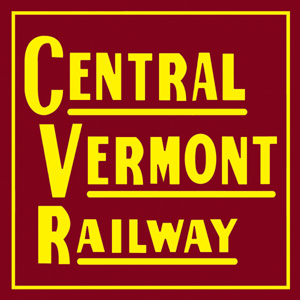 The Central Vermont Railway (reporting mark CV) was a railroad that operated in the U.S. states of Connecticut, Massachusetts, New Hampshire, New York, and Vermont, as well as the Canadian province of Quebec. It connected Montreal, Quebec, with New London, Connecticut, using a route along the shores of Lake Champlain, through the Green Mountains and along the Connecticut River valley, as well as Montreal to Boston, Massachusetts, through a connection with the Boston and Maine Railroad at White River Junction, Vermont.
The Central Vermont Railway (reporting mark CV) was a railroad that operated in the U.S. states of Connecticut, Massachusetts, New Hampshire, New York, and Vermont, as well as the Canadian province of Quebec. It connected Montreal, Quebec, with New London, Connecticut, using a route along the shores of Lake Champlain, through the Green Mountains and along the Connecticut River valley, as well as Montreal to Boston, Massachusetts, through a connection with the Boston and Maine Railroad at White River Junction, Vermont.
The Vermont Central Railroad was chartered October 31, 1843 to build a line across the center of Vermont, running from Burlington on Lake Champlain east to Montpelier, and then southeast and south to Windsor on the Connecticut River. Initial plans had the main line running through Montpelier. However, due to the difficulty of building through the Williamstown Gulf, a narrow valley south of Barre, Vermont, and to land interests of Charles Paine in Northfield, Vermont, a course to the west was selected, leaving the state capital to be serviced by a short branch line. Construction began on December 15, 1845, and the first section, from White River Junction west to Bethel, opened on June 26, 1848. Subsequent sections opened to Roxbury on September 17, 1848, Northfield on October 10, 1848, Montpelier (including the branch from Montpelier Junction) on June 20, 1849, Middlesex on August 30, 1849, Waterbury on September 29, 1849, and the full distance to Burlington on December 31, 1849. The part along the Connecticut River from Hartford south to Windsor opened on February 13, 1849.
On February 3, 1995, the CN sold the CV mainline from New London, Connecticut, to East Alburg, Vermont, to shortline operating company RailTex, which renamed the property New England Central Railroad. RailTex was merged into RailAmerica in 2000. Genesee & Wyoming acquired RailAmerica at the end of 2012. Operations have continued to present as before.

The Vermont Central Railroad was chartered October 31, 1843 to build a line across the center of Vermont, running from Burlington on Lake Champlain east to Montpelier, and then southeast and south to Windsor on the Connecticut River. Initial plans had the main line running through Montpelier. However, due to the difficulty of building through the Williamstown Gulf, a narrow valley south of Barre, Vermont, and to land interests of Charles Paine in Northfield, Vermont, a course to the west was selected, leaving the state capital to be serviced by a short branch line. Construction began on December 15, 1845, and the first section, from White River Junction west to Bethel, opened on June 26, 1848. Subsequent sections opened to Roxbury on September 17, 1848, Northfield on October 10, 1848, Montpelier (including the branch from Montpelier Junction) on June 20, 1849, Middlesex on August 30, 1849, Waterbury on September 29, 1849, and the full distance to Burlington on December 31, 1849. The part along the Connecticut River from Hartford south to Windsor opened on February 13, 1849.
On February 3, 1995, the CN sold the CV mainline from New London, Connecticut, to East Alburg, Vermont, to shortline operating company RailTex, which renamed the property New England Central Railroad. RailTex was merged into RailAmerica in 2000. Genesee & Wyoming acquired RailAmerica at the end of 2012. Operations have continued to present as before.
Brand/Importer Information: Micro-Trains is the brand name used by both Kadee Quality Products and Micro-Trains Line. For a history of the relationship between the brand and the two companies, please consult our Micro-Trains Collector's Guide.
Manufacturer Information:  Kadee Quality Products originally got involved in N-Scale by producing a scaled-down version of their successful HO Magne-Matic knuckle coupler system. This coupler was superior to the ubiquitous 'Rapido' style coupler due to two primary factors: superior realistic appearance and the ability to automatically uncouple when stopped over a magnet embedded in a section of track. The success of these couplers in N-Scale quickly translated to the production of trucks, wheels and in 1972 a release of ready-to-run box cars.
Kadee Quality Products originally got involved in N-Scale by producing a scaled-down version of their successful HO Magne-Matic knuckle coupler system. This coupler was superior to the ubiquitous 'Rapido' style coupler due to two primary factors: superior realistic appearance and the ability to automatically uncouple when stopped over a magnet embedded in a section of track. The success of these couplers in N-Scale quickly translated to the production of trucks, wheels and in 1972 a release of ready-to-run box cars.
In October 1990 Kadee separated in two companies, with the newly created Micro-Trains® Line Co. continuing the Z, Nn3, and N Scale product ranges, with Kadee retaining the HO range.

In October 1990 Kadee separated in two companies, with the newly created Micro-Trains® Line Co. continuing the Z, Nn3, and N Scale product ranges, with Kadee retaining the HO range.
Item created by: Lethe on 2015-05-31 17:46:30. Last edited by gdm on 2021-02-27 12:27:09
If you see errors or missing data in this entry, please feel free to log in and edit it. Anyone with a Gmail account can log in instantly.
If you see errors or missing data in this entry, please feel free to log in and edit it. Anyone with a Gmail account can log in instantly.


